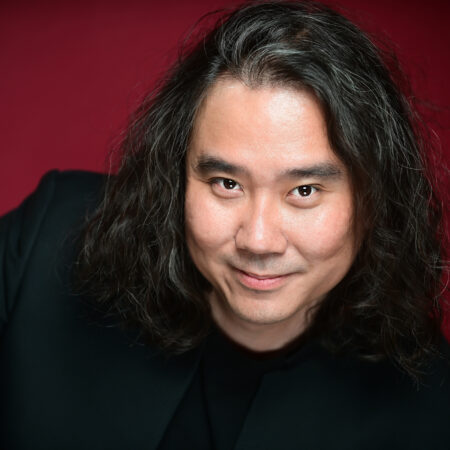New England Philharmonic closes season with “People in Between”
The New England Philharmonic closed its season Sunday afternoon with a trio of works under the theme “People in Between,” two of them local premieres.
Led by music director Tianhui Ng, the program, presented at Boston University’s Tsai Performance Center, began with Adeliia Faizullina’s Bolghar. Born in Uzbekistan of Tatar descent, she is a composer, instrumentalist and player of the quray (a flute-like Tatar folk instrument) Faizullina also happens to be blind. Bolghar was inspired by her visit to this ancient Tatar city.
Due to the unavailability of the quray, Faizullina’s work was performed in a version for three flutes. This musical portrait of the ancient city combines overtones generated by playing flageolets with open strings. The three soloists use the sound of air and repeated patterns with slight differences, representing rituals. Rhythms also play an important role – Faizullina uses several percussion instruments but also col legno with the strings; All these sounds mimic the combination of busy traffic and animal noises.
Sometimes in the piece, musical gestures finish abruptly, returning to a completely different color. In the climax, the music oscillates between the past and present, ending peacefully with sounds like raindrops.
Another Boston premiere, Thomas de Hartmann’s Violin Concerto, Op. 66 followed, with Danielle Maddon, New England Philharmonic concertmaster, as soloist.
The composer was a Russian aristocrat born in the Ukraine, and represents the quintessential “in between” person. Hartmann flew to Paris where he composed the concerto, grieving for his lost Ukrainian homeland, and dedicated it to a Jewish violinist who died in Paris in hiding. Hartmann’s house was seized by the occupying Nazis, and the composer emigrated to New York where he successfully composed film music.
Hartmann’s Violin Concerto is written in a Late Romantic style, with lush melodies and gorgeous harmonies that are often achingly beautiful.
The first movement began with a melancholic, muted melody that the violin soloist accelerates and the orchestra sensitively accompanies before ending with virtuoso violin passages, which were not always in synch with the orchestra. The Andante featured meditative melodies in the solo violin accompanied by pizzicato in the strings. After ending with a mini-cadenza in the solo violin, the dance-like Menuet fantasque, follows in a Shostakovich-style manner, ending with a splash.
Maddon was a committed soloist but her playing suffered from fitful intonation issues, as well as wayward brass in the orchestra.
The concert concluded with Dmitri Shostakovich’s 80-minute Symphony No. 7 “Leningrad”—a work that is all too timely in its depiction of a country besieged by foreign invaders.
The invasion-themed Allegretto begins with a sweeping, majestic and resolute March-like melody that continues in the woodwinds. High violins with a spherical melody lead over to a solo in the first violin that is underlined by rhythms from percussion and strings. The melody then turns more frenetic in violins and percussion and picks up speed. A melancholic melody with sad clarinet and violins was followed by muted trumpets and string pizzicato that ended abruptly.
The Moderato poco allegretto featured quiet, playful string and woodwind themes and ended with harp and a sad clarinet. Harps and woodwinds continued in the Adagio with a slow initial theme and were then joined by a brass choral.
The March-like Allegro non troppo starts with a quiet, searching melody in the strings that slowly rises in pitch – a long lament for the deceased. The high strings create a piercing sound and are joined by the woodwinds. A very soft, foreboding transition section with English horn and celli provided a contrast. After an intersection with violins and harp, oboe and then trumpet sounded a warning cry after which brass and strings joined forces to provide a bombastic ending as a universal symbol of resilience against fascism and totalitarianism.
Tianhui Ng confidently and clearly led the musicians through this long and difficult symphony. The program was imaginative and timely, and although the playing was generally dedicated, the orchestra consistently struggled with intonation and ensemble issues.
Posted in Performances





